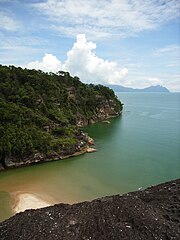Borneo shark
| Borneo shark | |
|---|---|

| |
| Scientific classification | |
| Domain: | Eukaryota |
| Kingdom: | Animalia |
| Phylum: | Chordata |
| Class: | Chondrichthyes |
| Subclass: | Elasmobranchii |
| Subdivision: | Selachimorpha |
| Order: | Carcharhiniformes |
| Family: | Carcharhinidae |
| Genus: | Carcharhinus |
| Species: | C. borneensis
|
| Binomial name | |
| Carcharhinus borneensis (Bleeker, 1858)
| |

| |
| Present (dark blue) and possible historical (light blue) range of the Borneo shark[2][3] | |
| Synonyms | |
|
Carcharias borneensis Bleeker, 1858 | |
The Borneo shark (Carcharhinus borneensis) is a
Almost nothing is known about the natural history of the Borneo shark. It is
Taxonomy and phylogeny
Dutch
The
Description
The Borneo shark is slim-bodied, with a long, pointed snout and oblique, slit-like nostrils preceded by narrow, nipple-shaped flaps of skin. The eyes are rather large and circular, and equipped with nictitating membranes. The corners of the sizable mouth bear short, indistinct furrows, and immediately above are a series of enlarged pores that are unique within the genus. There are 25–26 upper and 23–25 lower tooth rows. The upper teeth have a single, narrow, oblique cusp with strongly serrated edges, and large cusplets on the trailing side. The lower teeth are similar, but tend to be more slender and finely serrated. The five pairs of gill slits are short.[3][5]
The
Distribution and habitat

All recent specimens of the Borneo shark have been collected solely from fishery landing sites at
Biology and ecology
Human interactions
The
References
- ^ . Retrieved 24 May 2023.
- ^ a b c Dulvy, N.K., Bin Ali, A., Derrick, D., Dharmadi & Fahmi. (2021). "Carcharhinus borneensis". p. e.T39367A124407121.
{{cite web}}: CS1 maint: multiple names: authors list (link) - ^ ISBN 978-1-921605-57-4.
- ^ Bleeker, P. (1858). "Twaalfde bijdrage tot de kennis der vischfauna van Borneo. Visschen van Sinkawang". Acta Societatis Regiae Scientiarum Indo-Neêrlandicae. 5 (7): 1–10.
- ^ ISBN 92-5-101384-5.
- ^ Garrick, J.A.F. (1982). Sharks of the genus Carcharhinus. NOAA Technical Report, NMFS CIRC 445.
- ISBN 0-691-08453-X.
- ^ ISBN 978-1-921605-59-8.
- ^ ISBN 978-3-89937-132-1.
External links
![]() Media related to Carcharhinus borneensis at Wikimedia Commons
Media related to Carcharhinus borneensis at Wikimedia Commons

